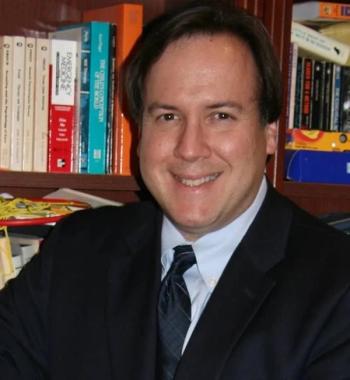
Restoring Respect to People With Mental Illness
It takes decisive action, not words, to really end stigma.
COMMENTARY
Everyone talks about ending the stigma attached to mental illness, but almost no one does anything meaningful about it. Recurring anti-stigma campaigns rely on empty rhetoric and never have any lasting impact.
It takes decisive action, not words, to really end stigma. I have seen this happen only three times in my career-45 years ago at the Tremont Crisis Center in Bronx, New York, and currently in
The key is using the money saved from closing psychiatric beds to fund community treatment, day centers, home visits, social clubs, group homes, housing, and (most creatively) business start-ups that offer patients productive, paying jobs.
In Ainancho, patients staff a hotel, spa, restaurants, a catering service, convenience stores, a landscaping company, a nursery, a fish farm, a cemetery, a camping site, and extensive groves of profitable avocado and orange trees. People living in the United States with equivalent severity of illness might well be homeless or in jail. In Ainancho, they are instead fully incorporated into the social life of the city and vital to its economic functioning.
In Trieste and Ainancho, ex-patients work side by side with the other townspeople and soon seem indistinguishable from them. They participate actively in town holidays, festivals, sports, and religious functions. As
The Trieste/Ainancho model is not only big-hearted, it is also cost effective. The US wastes tens of billions of dollars yearly on many easily avoidable indirect costs of severe mental illness. One third of our enormous prison and police budgets are wasted because the mentally ill are inappropriately mishandled in the expensive correctional system.
It is not just more humane but also far cheaper to promote recovery in the community than to isolate people in costly institutions. Better emotionally, but also economically, for patients to earn a paycheck than to receive a disability check. The modest budget of the Ainancho program comes from a combination of public insurance and its business revenues.
Conservative opposition
Trieste has inspired many dozens of programs around the world, including Ainancho, but it is unique in Italy. Ainancho is also unique in Japan. Sadly, the great success of their shared model at its point of origin has not inspired even the nearby cities to follow suit. The model has obvious appeal but is very difficult to initiate and also triggers considerable skepticism and opposition.
Some of this arises from understandable fear. Persons with untreated serious mental illness sometimes do bizarre and embarrassing things-and occasionally even become violent. Mental health and community leaders worry that closing beds will lead to bedlam. It requires seeing to believe this does not happen. Most people never have the opportunity to experience the model first hand and tend to disbelieve glowing second-hand stories of its success.
I was among this quite skeptical group until I got to visit Trieste multiple times, talked to staff members and program beneficiaries, and got a real feel for its approach. I was inspired again recently when I saw the model perform so brilliantly also in Ainancho. When high-quality community treatment, support, and housing are provided, patients become much less sick and blend in well as ordinary people. Before long, coworkers and neighbors forget that they were once so ill.
Most people working in mental health fear the unfamiliar and have come to rely far too heavily on medication. Focusing too much on the biological component of mental illness has reduced attention to the psychological, social, and environmental forces that are crucial to healing. Clinical practices and habits developed over a long career must be dramatically revised if staff is to work well within a new model that is much less medical, coercive, and hierarchical.
It is not just more humane but also far cheaper to promote recovery in the community than to isolate people in costly institutions.
And there are conflicts of interest that block acceptance, both financial and intellectual. The Trieste/Ainancho model cuts into the funding and prestige of clinicians and researchers who have fashioned their careers within a narrow bio-reductionistic model. People who are not enthusiastic supporters of the model fear it as a threat to their professional identities and livelihoods.
Getting the Trieste/Ainancho model started is a heroic endeavor that requires brave, charismatic leadership; deep community commitment; unwavering determination in the face of opposition; great diplomatic skill; and street-smart business savvy. The community and politicians must be convinced. The staff must be retrained. Housing must be identified. Community facilities must be built, bought, or rented. Business start-ups must be created. Preserving the model requires institutionalizing and decentralizing the community programs and business ventures so that they are resilient and self-sustaining over generations of successive leadership transitions.
This sounds daunting and it is. But far from impossible. Trieste has worked extremely hard, in close collaboration, with the World Health Organization, to provide training on its values and practices to thousands of diverse mental health professionals. Parts of its model are already in place in dozens of communities all around the world. The invigorated, international recovery movement has a similar set of values and practices that provide patient empowerment and reduce stigma. And the city of Gheel in Belgium provides wonderful historical and ongoing proof that the Trieste model can endure and thrive for centuries.
Can the model be scaled up in the US?
Los Angeles is carefully studying the Trieste model and hoping to adapt some its values and techniques. This shows much promise, but we must recognize the problems inherent in scaling up from small cities to a giant metropolis.
Ainancho and Trieste share similarities, specific to them, that facilitated their successful inclusion of the mentally ill as full-fledged citizens. What worked beautifully for them does not always translate in any simple way to the much more chaotic conditions facing persons with mental illness in America's big cities.
Trieste and Ainancho both have gradually declining populations, making housing affordable and readily available. Our big cities have a chronic housing shortage and recent high-flying rents that have caused rapidly growing, impossible to hide, homelessness.
Focusing too much on the biological component of mental illness has reduced attention to the psychological, social, and environmental forces that are crucial to healing.
Trieste and Ainancho both have an aging population, making the mentally ill essential contributors to an otherwise sagging economy with an insufficient labor force. In our big cities, the mentally ill are more feared as an economic drain, than valued as useful workers who can contribute to the economy.
Family ties and a strong sense of responsibility to kin remain strong in Ainancho and Trieste. Our mentally ill are often alone and adrift in big cities.
Community members in smaller cities are less anonymous, more likely to know each other, and to have a sense of commonality and shared interest. In big cities, the consensus is usually an exclusionary "not in my neighborhood."
Community leaders in Ainancho and Trieste live close to their constituents, know their needs and feel them personally, and were prepared to embrace a plan that provides a rich environment of social relatedness for the mentally ill. Big city politicians are more likely to work for the elites, distance themselves from the needy, and look the other way when the mentally ill are jailed or left homeless on the streets.
Los Angeles has seemingly insurmountable problems: tens of thousands of mentally ill people who are homeless or in jail; a housing shortage and impossibly high rents; and a huge population sprawled over an enormous geographic area. But it also has the strongest possible motivation for change because things are such a mess now. And it has achieved remarkable buy-in from all the relevant institutional players-mental health, the courts, district attorney, police, county jail, welfare agencies, philanthropy, business interests, and most importantly, the politicians. Officials from LA have made frequent trips to Trieste and are imbibing its spirit and practice. If any American city can turn crisis into opportunity, it is Los Angeles.
The vision
Los Angeles cannot possibly expect to transport all the practices that make Trieste and Ainancho so great-many of which are geared to the conditions of smaller cities with a declining population, insufficient workforce, and lots of housing. But LA can learn a great deal from the vision and attitudes that inform Trieste and Ainancho.
Find the strengths, not just focus on the problems, of the mentally ill. Treat them in community, not institutional, settings. Promote respect and social inclusion as keys to healing. Housing first. Socialization second. Jobs third. Meds are often necessary, but never sufficient.
Trieste and Ainancho are the best places in the world to be mentally ill. The United States is the worst-life could not be more degrading for the 350,000 mentally ill people languishing in our jails and the 250,000 who are sleeping rough on our streets. This was not always the case in the United States. We actually led the community psychiatry movement that followed the massive deinstitionalization of inpatients in the 1960s. The Kennedy administration established community mental health centers throughout the country. I worked in one in the Bronx that was a prototype for what soon followed in Trieste. But all this collapsed when the Reagan Administration cut funding in the 1980s. Things have degenerated ever since.
Trieste and Ainancho provide the inspiration that we can once again provide a decent life for the mentally ill. They also present the stark moral challenge that we must.
Dr Frances is Professor Emeritus and former Chair, Department of Psychiatry, Duke University; Chair, DSM-IV Task Force; and author of Saving Normal and Essentials of Psychiatric Diagnosis.
References:
1. Sullivan HS. Conceptions of Modern Psychiatry. New York: W.W. Norton & Co.; 1940.
Newsletter
Receive trusted psychiatric news, expert analysis, and clinical insights — subscribe today to support your practice and your patients.













